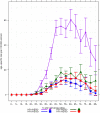A rapid rise in hormone receptor-positive and HER2-positive breast cancer subtypes in Southern Thai women: A population-based study in Songkhla
- PMID: 35344552
- PMCID: PMC8959182
- DOI: 10.1371/journal.pone.0265417
A rapid rise in hormone receptor-positive and HER2-positive breast cancer subtypes in Southern Thai women: A population-based study in Songkhla
Abstract
The incidence of breast cancer is increasing in low- and middle-income countries, including Thailand. However, its molecular immunohistochemical (M-IHC) subtypes have not been summarized in a population-based cancer registry. Thus, we aimed to estimate the breast cancer incidence and trends based on the hormone receptor and human epidermal growth factor receptor 2 (HER2) status. This cross-sectional study included 2,883 women diagnosed with primary invasive breast cancer between 2009 and 2018 from the Songkhla Cancer Registry. After imputing the missing values of estrogen receptor (ER), progesterone receptor (PR), and HER2 status, the cases were classified into four subtypes: HR+/HER2-, HR+/HER2+, HR-/HER2-, and HR-/HER2+. The age-specific incidence rate of 5-year age groups and age-standardized incidence rate (ASR) were calculated. An age-period-cohort (APC) model was used to describe the effects of age, birth cohort, and period of diagnosis. Finally, the incidence trends were extrapolated to 2030 based on the APC and joinpoint models. The results showed, HR+/HER2- had the highest ASR in breast cancer. The incidence trends of HR+/HER2- and HR+/HER2+ increased with an annual percent change of 5.4% (95%CI: 2.5% to 8.3%) and 10.1% (95%CI: 4.9% to 15.5%), respectively. The rate ratio was high in the younger generation and recent period of diagnosis. The joinpoint and APC model projections showed that the ASR of HR+/HER2- would reach 30.0 and 29.2 cases per 100,000 women, while ASR of the HR+/HER2+ would reach 8.8 and 10.4 cases per 100,000 women in 2030. On the other hand, the incidence trends of the HR-/HER2- and HR-/HER2+ subtypes were stable. The rising trends of HR-positive and a part of HER2-positive breast cancer forecast a dynamicity of the future health care budgeting, resource allocation, and provision of facilities.
Conflict of interest statement
The authors have declared that no competing interests exist.
Figures



Similar articles
-
A population-based study of Kurdish breast cancer in northern Iraq: hormone receptor and HER2 status. A comparison with Arabic women and United States SEER data.BMC Womens Health. 2012 Jun 22;12:16. doi: 10.1186/1472-6874-12-16. BMC Womens Health. 2012. PMID: 22727195 Free PMC article.
-
Occurrence of breast cancer subtypes in adolescent and young adult women.Breast Cancer Res. 2012 Mar 27;14(2):R55. doi: 10.1186/bcr3156. Breast Cancer Res. 2012. PMID: 22452927 Free PMC article.
-
Asian ethnicity and breast cancer subtypes: a study from the California Cancer Registry.Breast Cancer Res Treat. 2011 Jun;127(2):471-8. doi: 10.1007/s10549-010-1173-8. Epub 2010 Oct 19. Breast Cancer Res Treat. 2011. PMID: 20957431 Free PMC article.
-
From bench to bedside: What do we know about hormone receptor-positive and human epidermal growth factor receptor 2-positive breast cancer?J Steroid Biochem Mol Biol. 2015 Sep;153:45-53. doi: 10.1016/j.jsbmb.2015.05.005. Epub 2015 May 18. J Steroid Biochem Mol Biol. 2015. PMID: 25998416 Free PMC article. Review.
-
Genetics, Treatment, and New Technologies of Hormone Receptor-Positive Breast Cancer.Cancers (Basel). 2023 Feb 18;15(4):1303. doi: 10.3390/cancers15041303. Cancers (Basel). 2023. PMID: 36831644 Free PMC article. Review.
Cited by
-
Breast cancer stage and molecular subtype distribution: real-world insights from a regional oncological center in Hungary.Discov Oncol. 2024 Jun 22;15(1):240. doi: 10.1007/s12672-024-01096-9. Discov Oncol. 2024. PMID: 38907840 Free PMC article.
-
The effectiveness and safety of palbociclib and ribociclib in stage IV HR+/HER-2 negative breast cancer: a nationwide real world comparative retrospective cohort study.Front Oncol. 2023 Dec 15;13:1203684. doi: 10.3389/fonc.2023.1203684. eCollection 2023. Front Oncol. 2023. PMID: 38162489 Free PMC article.
-
Cancer Patient-Derived Cell-Based Models: Applications and Challenges in Functional Precision Medicine.Life (Basel). 2024 Sep 10;14(9):1142. doi: 10.3390/life14091142. Life (Basel). 2024. PMID: 39337925 Free PMC article. Review.
References
-
- International Agency for Research on Cancer (IARC). Cancer today. [cited 28 Feb 2021]. http://gco.iarc.fr/today/home
-
- Sripan P, Sriplung H, Pongnikorn D, Bilheem S, Virani S, Waisri N, et al.. Clinical subtypes of breast cancer in Thai women: a population-based study of Chiang Mai province. Asian Biomed. 2019;13: 11–17. doi: 10.1515/abm-2019-0034 - DOI
MeSH terms
Substances
LinkOut - more resources
Full Text Sources
Medical
Research Materials
Miscellaneous

